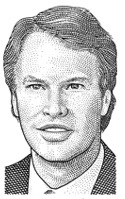 McClatchy Co. CEO Gary Pruitt addressed the Newspaper Association of America’s annual convention on Monday. Here are his remarks, courtesy of the NAA.
McClatchy Co. CEO Gary Pruitt addressed the Newspaper Association of America’s annual convention on Monday. Here are his remarks, courtesy of the NAA.
Each year at McClatchy’s shareholders meeting, we conclude with a video highlighting the work of our photojournalists over the past year. I pick a song that I think speaks to the year and we set the photographs to the music. This year, I wasn’t sure which song to choose. I like the Rolling Stones, and they have several songs that fit our current economic environment:
- “I Can’t Get No Satisfaction,” of course. But also consider …
- “You Can’t Always Get What You Want”
- “19th Nervous Breakdown”
- “Shattered” and
- “Gimme Shelter”
But I really don’t feel fatalistic. I speak to you this morning with a strong sense of resolve and hope. We have a serious fight on our hands, but I believe we are up to it. So I thought it more appropriate to select a battle song for this year’s video – the “Battle Hymn of the Republic” to be specific – as we fight to ensure that truth does indeed go marching on. See what you think …. (Plays DVD)
Public Service Mandate
I came to newspapers not as a journalist or a businessman but as a First Amendment lawyer from Berkeley, California. So as you might expect, I’m passionate about free speech and a free press. I believe in the idea – and the ideal – that newspapers should provide high quality public service journalism so that the public can fully participate in democracy. This is not just some abstract concept. There is emerging empirical evidence to support the important relationship between democracy and the press.
A study published in The Journal of Law, Economics and Organization in 2003 looked at the per capita circulation of newspapers in different countries around the world and among the states in our own country. The study found that the lower the circulation, the greater the political corruption. Of course, the First Amendment isn’t a business model. Making the case that we’re important to society – proving it, even – does not guarantee our success. It just means the stakes are high. It is up to us to devise a business model that will sustain quality, public service journalism.
Our critics and the naysayers aren’t going to do it. This is the challenge before us. So while there were easier times to lead newspapers, there has never been a more important time.
Future generations will judge how we do. Or, as Abraham Lincoln said so eloquently in 1862 during an even more historic fight: “We can not escape history … The fiery trial through which we pass will light us down in honor or dishonor to the latest generation.”
Competitive History
I think history has much to teach us. As Mark Twain said, “History may not repeat itself but it does rhyme a lot.” Newspapering, for much of its history, was a fiercely competitive, rough-and-tumble, dog-eat-dog, low-margin business.
Consider The Sacramento Bee. In the first 30 years of its life, from 1857 to 1887, 80 newspapers came and went in the Sacramento market. That was a tough business. The number of daily newspapers in the United States peaked in the early part of the 20th century. There have never been more newspapers before or since.
Not coincidentally, that same time period witnessed the birth of a new medium — commercial radio. First radio and then television emerged, taking share from existing media, namely newspapers. Many people predicted newspapers would go out of business – and many did. So many, in fact, that by the second half of the 20th century, all but the largest cities in the United States had only one daily newspaper. And then a funny thing happened. Those successful, scrappy, surviving newspapers got rich because there was no other print or classified advertising competition. It’s a noteworthy paradox that the development of radio and TV ultimately led to the enrichment of newspapers.
For the first time in the history of newspapers, profit margins exploded and newspapering became an easy and lucrative business. Warren Buffett once said: “You want to invest in a business that even your stupid cousin could run, because one day he will.” That was the newspaper business in the second half of the 20th century. As newspapers’ profit margins grew, so did their cost structures. Ah, but we were so much older then; we’re younger than that now.
New Disruption
The Golden Age of newspapering wasn’t to last. With the maturation of the Internet over the past decade, a new medium has emerged, a virulent competitor again taking advertising share from all existing media, especially share of classified advertising. The Internet’s impact has been particularly disruptive at large metro papers with their higher cost structures and greater dependence on classified advertising.
Some of our critics seem to think newspapers were blindsided by the Internet’s potential impact. But we deserve credit for the considerable progress we’ve made online. The U.S. newspaper industry generated $3 billion in digital revenue last year. At McClatchy, 15% of our advertising revenue today comes from online.
McClatchy, a company founded before the advent of electric lights, will generate nearly $200 million dollars in digital revenue this year at a higher profit margin than our print business. Our digital revenue and online audience grew by double digits last year and, we operate the leading local internet business in each of our daily newspaper markets.
None of which is to say this transition is easy or that we haven’t made mistakes along the way. Secular transitions are always disruptive and painful for all media — what Austrian economist Joseph Schumpeter called “the creative destruction of capitalism.”
Working On It
My point is that newspaper companies, to varying degrees, were working their way through it, difficult as it was. The game-changer was the arrival of the deepest and most painful recession in generations. It’s the combination of the secular shift and the cyclical downturn that has created a very real crisis for newspapers.
Many of our critics conflate the secular and the cyclical. They see the revenue declines brought about by the recession as proof we can’t weather the secular transition. This leads to the wrong, but increasingly popular conclusion, that there’s no viable future for newspaper companies.
Absolutely we’ve got a future. But just what does it look like and how do we hurry up and get there? Alan Kay, the visionary computer scientist, once said, “The best way to predict the future is to invent it.” That’s where we are today. It’s up to us to invent that future.
There is no silver bullet. There are no easy answers. And, sadly, as we have seen already, not every newspaper will make it. But here is what I see going forward:
Reinvention
Print remains viable now and into the future. Most newspapers today are profitable even in the depths of this crippling recession. More than 100 million adults in the United States read a printed newspaper every day – more than watched the Super Bowl. As troubled as the U.S. economy is, if 100 million consumers want and use something, that product usually doesn’t go away.
Sixty-one percent of 18 to 34-year-olds read a newspaper in an average week. So much for the notion that younger people don’t read newspapers.
Despite all these positives, newspapers alone are not enough. Our future depends on becoming successful hybrid media companies – fully engaged and vested in digital publishing and digital platforms as we have been historically with print. This isn’t breaking news. In the month of January, 44 percent of all U.S. internet users visited a newspaper website. And audience growth at newspaper websites is outpacing overall U.S. internet audience growth.
So we’ve been moving in this digital direction for some time – but we need to accelerate the pace and sharpen our focus. We need to establish our brands and offer our services on many different platforms. We need to leverage social media, mobile technology and the web’s interactivity as our communities and customers change how they acquire and share information.
This economic downturn makes it difficult to take risks, but we need to experiment smartly and partner where it makes sense. We need to learn from our mistakes, adjust and move on. Let’s listen to our audience and our advertisers – not conventional wisdom.
Transform the Business
The same technology that challenges us on the revenue side offers savings on the expense side through centralization, collaboration and outsourcing. We must continue to shed those legacy, 20th century, monopoly cost structures that weigh us down, limit our flexibility, jeopardize our health.
Think of the newspaper company of the future as an athlete – lean, fit and trim, yet muscular where we need to be. We need to ensure strength in our newsrooms and advertising sales staffs – our two most powerful assets, our core competencies and our social responsibility. Even today, with all the downsizing across our industry, we have the largest newsgathering operations in our markets by far. No other local media outlet is as well equipped to produce and deliver the high value, premium local content that’s growing our total audience in print and online. And we know that audience growth remains the best predictor of long-term success for any medium.
While we’ve done a good job growing audience, we need to do a better job of leveraging our sales forces. We must empower our sales staffs to sell our full portfolio of print and digital products – giving them the right tools, training and incentives. Also, think of the possibilities of harnessing that large, local sales staff to sell on behalf of others and share revenues. The untapped potential of local digital advertising in each of our markets is why internet giants like Yahoo and Google seek partnerships with newspapers. We need to mine that local digital revenue stream. We can’t afford to fumble the opportunity.
Lastly, we need to accept the reality that we’re in a tougher, more competitive business, now and forever. Ours is a business that’s still viable and vital – just with a smaller margin for profits and a smaller margin for error. Let’s appreciate how lucky we are to work in the media business in this critical time of transition. Our actions count. No unbearable lightness of being here. The ball is in our hands and the game is on the line.
I’d like to leave you this morning with a bit of inspiration from Bob Dylan and his song “Silvio.” Although written more than 20 years ago now, I think Dylan’s lyrics speak to the newspaper industry today:
Stake my future on a hell of a past
Looks like tomorrow is coming on fast
Ain’t complaining ’bout what I got
Seen better times, but who has not?
 “Research has shown that the downside of powerful, centralized networks is their susceptibility to being subverted and exploited,” writes The Wall Street Journal’s Christopher Mims in a fascinating analysis of why social networks, which were supposed to challenge hierarchy, have reinforced it instead.
“Research has shown that the downside of powerful, centralized networks is their susceptibility to being subverted and exploited,” writes The Wall Street Journal’s Christopher Mims in a fascinating analysis of why social networks, which were supposed to challenge hierarchy, have reinforced it instead.
 McClatchy Co. CEO
McClatchy Co. CEO 
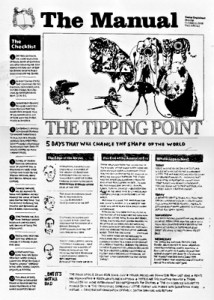 A team of enterprising publishers in the UK produced a four-page
A team of enterprising publishers in the UK produced a four-page 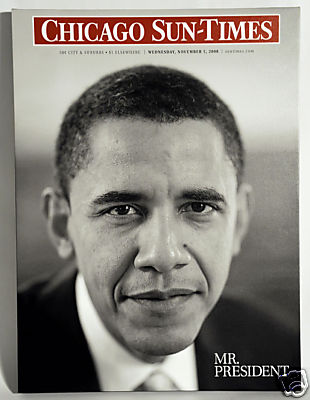 The Chicago Sun-Times
The Chicago Sun-Times 

 The Onion offered a tutorial in how to write a provocative magazine cover line (right).
The Onion offered a tutorial in how to write a provocative magazine cover line (right). The Simpsons showed its snotty character Nelson insulting a journalist. “Hah hah! Your medium is dying!”
The Simpsons showed its snotty character Nelson insulting a journalist. “Hah hah! Your medium is dying!”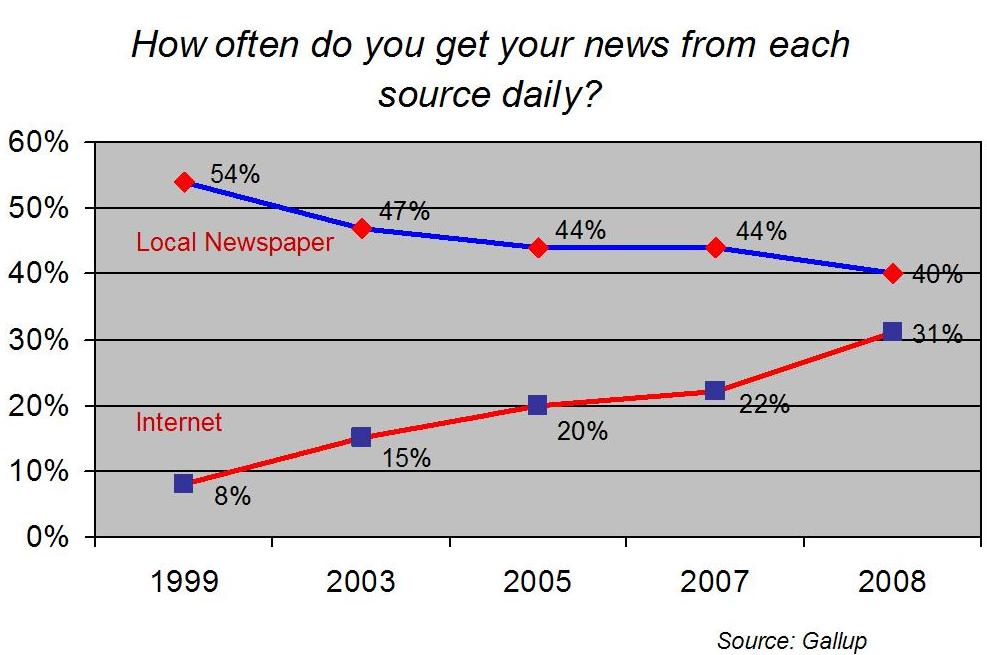


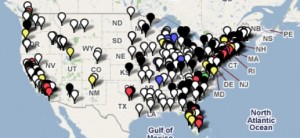

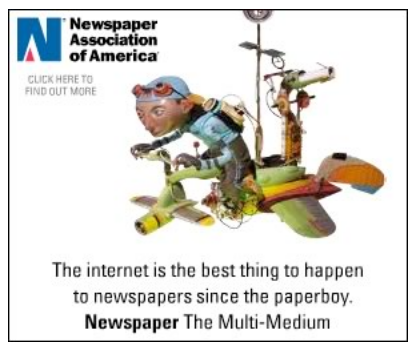
 And Advertising Age
And Advertising Age 

